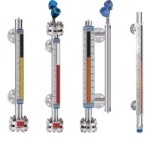 |
| Magnetic Level Indicators Courtesy Orion Instruments |
- Construction that is resistant to breakage.
- Measuring indicators, switches, and transmitters mounted externally, without contacting the medium being measured.
- Maintenance free operation. No regular cleaning needed.
- Readable level indication from greater distance than glass sight gauges.
- Magnetic level indicators can accommodate greater fluid level ranges without the need for multiple instruments.
Orion Instruments, a Magnetrol company and industry leader, has produced a comprehensive guide to magnetic level gauges, switches, transmitters, and related products. It delivers experts and newcomers an understandable and clear description of the technology and principals of operation behind magnetic level gauges and instruments. The guide also assists the reader in properly specifying and selecting the best instrument configuration for an application. A table of contents at the front of the document helps readers to quickly find the information they need.
Take a couple minutes to roll through the document and you are likely to find new and useful application tips and product information. Any questions about magnetic level indicators or your process measurement and control applications can be clearly addressed by a product specialist.
